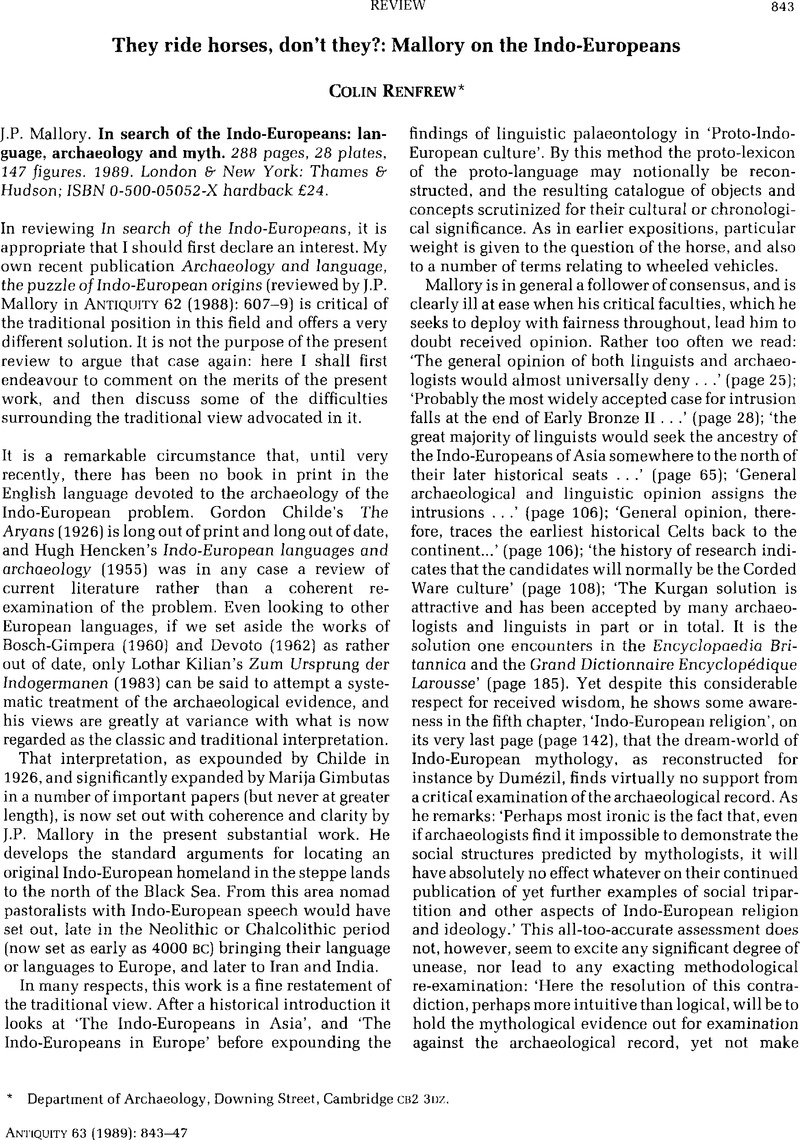Crossref Citations
This article has been cited by the following publications. This list is generated based on data provided by Crossref.
Linke, Uli
1992.
Manhood, Femaleness, and Power: A Cultural Analysis of Prehistoric Images of Reproduction.
Comparative Studies in Society and History,
Vol. 34,
Issue. 4,
p.
579.
1993.
Review Articles.
Journal of European Archaeology,
Vol. 1,
Issue. 1,
p.
195.
Librado, Pablo
Khan, Naveed
Fages, Antoine
Kusliy, Mariya A.
Suchan, Tomasz
Tonasso-Calvière, Laure
Schiavinato, Stéphanie
Alioglu, Duha
Fromentier, Aurore
Perdereau, Aude
Aury, Jean-Marc
Gaunitz, Charleen
Chauvey, Lorelei
Seguin-Orlando, Andaine
Der Sarkissian, Clio
Southon, John
Shapiro, Beth
Tishkin, Alexey A.
Kovalev, Alexey A.
Alquraishi, Saleh
Alfarhan, Ahmed H.
Al-Rasheid, Khaled A. S.
Seregély, Timo
Klassen, Lutz
Iversen, Rune
Bignon-Lau, Olivier
Bodu, Pierre
Olive, Monique
Castel, Jean-Christophe
Boudadi-Maligne, Myriam
Alvarez, Nadir
Germonpré, Mietje
Moskal-del Hoyo, Magdalena
Wilczyński, Jarosław
Pospuła, Sylwia
Lasota-Kuś, Anna
Tunia, Krzysztof
Nowak, Marek
Rannamäe, Eve
Saarma, Urmas
Boeskorov, Gennady
Lōugas, Lembi
Kyselý, René
Peške, Lubomír
Bălășescu, Adrian
Dumitrașcu, Valentin
Dobrescu, Roxana
Gerber, Daniel
Kiss, Viktória
Szécsényi-Nagy, Anna
Mende, Balázs G.
Gallina, Zsolt
Somogyi, Krisztina
Kulcsár, Gabriella
Gál, Erika
Bendrey, Robin
Allentoft, Morten E.
Sirbu, Ghenadie
Dergachev, Valentin
Shephard, Henry
Tomadini, Noémie
Grouard, Sandrine
Kasparov, Aleksei
Basilyan, Alexander E.
Anisimov, Mikhail A.
Nikolskiy, Pavel A.
Pavlova, Elena Y.
Pitulko, Vladimir
Brem, Gottfried
Wallner, Barbara
Schwall, Christoph
Keller, Marcel
Kitagawa, Keiko
Bessudnov, Alexander N.
Bessudnov, Alexander
Taylor, William
Magail, Jérome
Gantulga, Jamiyan-Ombo
Bayarsaikhan, Jamsranjav
Erdenebaatar, Diimaajav
Tabaldiev, Kubatbeek
Mijiddorj, Enkhbayar
Boldgiv, Bazartseren
Tsagaan, Turbat
Pruvost, Mélanie
Olsen, Sandra
Makarewicz, Cheryl A.
Valenzuela Lamas, Silvia
Albizuri Canadell, Silvia
Nieto Espinet, Ariadna
Iborra, Ma Pilar
Lira Garrido, Jaime
Rodríguez González, Esther
Celestino, Sebastián
Olària, Carmen
Arsuaga, Juan Luis
Kotova, Nadiia
Pryor, Alexander
Crabtree, Pam
Zhumatayev, Rinat
Toleubaev, Abdesh
Morgunova, Nina L.
Kuznetsova, Tatiana
Lordkipanize, David
Marzullo, Matilde
Prato, Ornella
Bagnasco Gianni, Giovanna
Tecchiati, Umberto
Clavel, Benoit
Lepetz, Sébastien
Davoudi, Hossein
Mashkour, Marjan
Berezina, Natalia Ya.
Stockhammer, Philipp W.
Krause, Johannes
Haak, Wolfgang
Morales-Muñiz, Arturo
Benecke, Norbert
Hofreiter, Michael
Ludwig, Arne
Graphodatsky, Alexander S.
Peters, Joris
Kiryushin, Kirill Yu.
Iderkhangai, Tumur-Ochir
Bokovenko, Nikolay A.
Vasiliev, Sergey K.
Seregin, Nikolai N.
Chugunov, Konstantin V.
Plasteeva, Natalya A.
Baryshnikov, Gennady F.
Petrova, Ekaterina
Sablin, Mikhail
Ananyevskaya, Elina
Logvin, Andrey
Shevnina, Irina
Logvin, Victor
Kalieva, Saule
Loman, Valeriy
Kukushkin, Igor
Merz, Ilya
Merz, Victor
Sakenov, Sergazy
Varfolomeyev, Victor
Usmanova, Emma
Zaibert, Viktor
Arbuckle, Benjamin
Belinskiy, Andrey B.
Kalmykov, Alexej
Reinhold, Sabine
Hansen, Svend
Yudin, Aleksandr I.
Vybornov, Alekandr A.
Epimakhov, Andrey
Berezina, Natalia S.
Roslyakova, Natalia
Kosintsev, Pavel A.
Kuznetsov, Pavel F.
Anthony, David
Kroonen, Guus J.
Kristiansen, Kristian
Wincker, Patrick
Outram, Alan
and
Orlando, Ludovic
2021.
The origins and spread of domestic horses from the Western Eurasian steppes.
Nature,
Vol. 598,
Issue. 7882,
p.
634.





